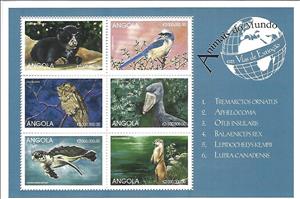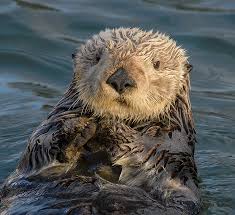Mini Sheet: Animals of the World in the Process of Extinction (Angola 1999)
Animals of the World in the Process of Extinction (Angola 1999)
25 March (Angola ) within release Animals of the World in the Process of Extinction goes into circulation Mini Sheet Animals of the World in the Process of Extinction face value 6*300000 Angolan kwanza
| Mini Sheet Animals of the World in the Process of Extinction in catalogues | |
|---|---|
| Michel: | Mi: AO 1329-1334KB |
| Stamp Number: | Sn: AO 1064 |
Mini Sheet is horizontal format.
Also in the issue Animals of the World in the Process of Extinction:
- Mini Sheet - Animals of the World in the Process of Extinction face value 6*300000;
- Stamp - Tremarctos ornatus face value 300,000;
- Stamp - Lepidochelys kempii face value 300,000;
- Stamp - Odocoileus virginianus face value 300,000;
- Souvenir Sheet - Ursus arctos horribilis face value 1,000,000;
- Stamp - Equus caballus przewalski face value 300,000;
- Mini Sheet - Animals of the World in the Process of Extinction face value 6*300000;
- Stamp - Panthera tigris altaica face value 300,000;
- Stamp - Pongo pygmaeus face value 300,000;
- Stamp - Ailuropada melanoleuca face value 1,000,000;
- Stamp - Leontopithecus rosalia rosalia face value 300,000;
- Stamp - Otus insularis face value 300,000;
- Stamp - Vulpes velox hebes face value 300,000;
- Souvenir Sheet - Ailuropada melanoleuca face value 1,000,000;
- Stamp - Aphelocoma face value 300,000;
- Stamp - Ursus arctos horribilis face value 1,000,000;
- Stamp - Mustela putorius face value 300,000;
- Stamp - Lutra canadensis face value 300,000;
- Stamp - Balaeniceps rex face value 300,000;
Mini Sheet Animals of the World in the Process of Extinction it reflects the thematic directions:
Animals are multicellular, eukaryotic organisms of the kingdom Animalia (also called Metazoa). All animals are motile, meaning they can move spontaneously and independently, at some point in their lives. Their body plan eventually becomes fixed as they develop, although some undergo a process of metamorphosis later on in their lives. All animals are heterotrophs: they must ingest other organisms or their products for sustenance.
Bears are carnivoran mammals of the family Ursidae (/ˈɜːrsɪdiː, -daɪ/). They are classified as caniforms, or doglike carnivorans. Although only eight species of bears are extant, they are widespread, appearing in a wide variety of habitats throughout most of the Northern Hemisphere and partially in the Southern Hemisphere. Bears are found on the continents of North America, South America, and Eurasia. Common characteristics of modern bears include large bodies with stocky legs, long snouts, small rounded ears, shaggy hair, plantigrade paws with five nonretractile claws, and short tails.
Birds (Aves), a subgroup of Reptiles, are the last living examples of Dinosaurs. They are a group of endothermic vertebrates, characterised by feathers, toothless beaked jaws, the laying of hard-shelled eggs, a high metabolic rate, a four-chambered heart, and a strong yet lightweight skeleton. Birds live worldwide and range in size from the 5 cm (2 in) bee hummingbird to the 2.75 m (9 ft) ostrich. They rank as the class of tetrapods with the most living species, at approximately ten thousand, with more than half of these being passerines, sometimes known as perching birds. Birds are the closest living relatives of crocodilians.
Otters are carnivorous mammals in the subfamily Lutrinae. The 13 extant otter species are all semiaquatic, aquatic, or marine. Lutrinae is a branch of the Mustelidae family, which includes weasels, badgers, mink, and wolverines, among other animals.
Owls are birds from the order Strigiformes, which includes over 200 species of mostly solitary and nocturnal birds of prey typified by an upright stance, a large, broad head, binocular vision, binaural hearing, sharp talons, and feathers adapted for silent flight. Exceptions include the diurnal northern hawk-owl and the gregarious burrowing owl.
Reptiles are tetrapod (four-limbed vertebrate) animals in the class Reptilia, comprising today's turtles, crocodilians, snakes, amphisbaenians, lizards, tuatara, and their extinct relatives. The study of these traditional reptile orders, historically combined with that of modern amphibians, is called herpetology. Because some reptiles are more closely related to birds than they are to other reptiles (e.g., crocodiles are more closely related to birds than they are to lizards), the traditional groups of "reptiles" listed above do not together constitute a monophyletic grouping (or clade). For this reason, many modern scientists prefer to consider the birds part of Reptilia as well, thereby making Reptilia a monophyletic class.
Marine life, or sea life or ocean life, refers to the plants, animals and other organisms that live in the salt water of the sea or ocean, or the brackish water of coastal estuaries. At a fundamental level, marine life helps determine the very nature of our planet. Marine organisms produce much of the oxygen we breathe. Shorelines are in part shaped and protected by marine life, and some marine organisms even help create new land. Altogether there are 230,000 documented marine species, including over 16,000 species of fish, and it has been estimated that nearly two million marine species are yet to be documented. Marine species range in size from the microscopic, including plankton and phytoplankton which can be as small as 0.02 micrometres, to huge cetaceans (whales, dolphins and porpoises) which in the case of the blue whale reach up to 33 metres (109 feet) in length, being the largest known animal.
Turtles are reptiles of the order Testudines, characterized by a special shell developed mainly from their ribs. Modern turtles are divided into two major groups, the Pleurodira (side necked turtles) and Cryptodira (hidden necked turtles), which differ in the way the head retracts. There are 360 living and recently extinct species of turtles, including land-dwelling tortoises and freshwater terrapins. They are found on most continents, some islands and, in the case of sea turtles, much of the ocean. Like other amniotes (reptiles, birds, and mammals) they breathe air and do not lay eggs underwater, although many species live in or around water.








